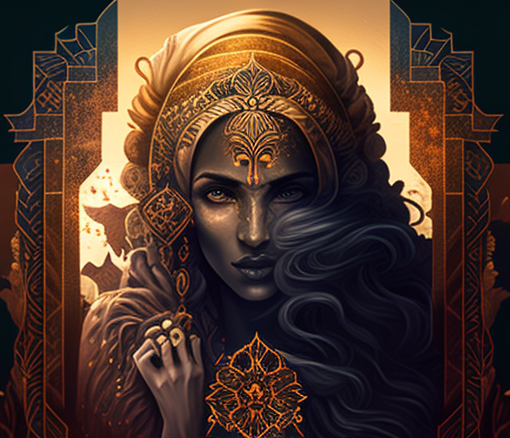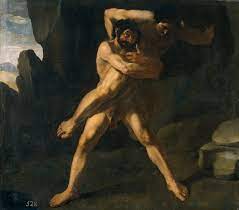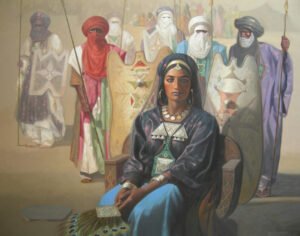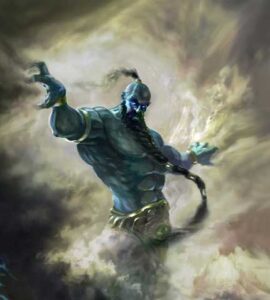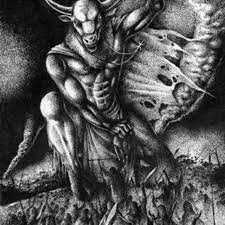Like every other civilizations, Berber mythology is a rich and diverse tradition that has been passed down through generations in North Africa. Berber myths and legends offer a glimpse into the beliefs, customs, and values of Berber people and reflect their connection to nature, spirits, and ancestors. In this article, we will explore some of the most fascinating Berber myths and legends.
1-Antaeus known to the Berbers as anti
he is the son of Poseidon and Gaea, Antaeus was a giant and the son of Gaia, the Earth goddess, and Poseidon, the sea deity. He was famed for his great power and was thought to be indestructible as long as he kept in touch with his mother, the soil.
According to legend, Antaeus would challenge tourists to wrestling bouts, which he would win by lifting them off the ground and drawing power from his connection to the soil. During his Twelve Labors, Heracles (Hercules) met Antaeus and found the source of his power. Heracles raised Antaeus from the ground, cutting him off from the earth, and vanquished him in a wrestling encounter.
Antaeus’ relationship with the Berbers is mostly established in geographical and cultural factors.
Berbers have a deep connection to their land and nature, which is reflected in their traditional beliefs and mythology. Antaeus, who drew strength from his connection to the soil, shares the Berber veneration for the land and its importance in their life. This resemblance most likely contributed to Antaeus’ incorporation in Berber mythology.
Antaeus may be seen as a metaphorical depiction of the earth’s power and life in Berber beliefs. Within the Berber cultural context, his narrative may have been altered to stress themes of resilience, groundedness, and the value of one’s roots.
2- Amun – God of the heavens and ruler of the universe:
Amun was one of the major gods in Berber mythology and was often associated with the heavens and the universe. He was considered to be a powerful and benevolent deity who could grant blessings and protect the people. In some Berber communities
3- The Legend of Tin Hinan : Founding Mother of the Tuareg Confederation
Tin Hinan is a legendary figure who is believed to have founded the Tuareg confederation in the 4th century. According to the legend, Tin Hinan was a queen who arrived in the Sahara from the north on a camel. She was accompanied by a retinue of women, and they settled in the region and introduced Islam to the local tribes. The Tuareg people regard Tin Hinan as the mother of their nation, and her tomb in the Hoggar Mountains in Algeria is a revered pilgrimage site.
4- The Story of Aisha Qandisha: The Enigmatic Female Spirit
Aisha Qandisha is a female jinn or spirit who is prominent in Moroccan folklore. She is said to live in rivers, springs, and other bodies of water, and she is known for her seductive powers and mischievous nature. In Berber mythology, Aisha Qandisha is associated with fertility and is sometimes depicted as a protector of women.
5- The Myth of the Imazighen
The Imazighen, or “free people,” are the indigenous Berber inhabitants of North Africa. According to Berber mythology, the Imazighen were created by the god Amun as a people of warriors and poets. The Imazighen were said to be fierce defenders of their land and culture, and they resisted various invaders throughout history, including the Romans, Arabs, and Europeans.
6- The Legend of Iblis: A Malevolent Force in Berber Mythology
Iblis is a malevolent jinn who appears in Berber mythology as a tempter and deceiver. According to the legend, Iblis was once a pious and devoted servant of Allah, but he fell from grace after he refused to bow down to Adam, the first human. Iblis was banished from heaven and became a sworn enemy of humanity. In Berber mythology, Iblis is often depicted as a trickster and a source of temptation.
7- The Story of the Djinn: Enigmatic Beings of Berber Lore
The djinn are supernatural beings that are prominent in Berber mythology. They are said to inhabit the earth and the skies, and they are associated with natural phenomena such as storms, earthquakes, and sandstorms. The djinn are often depicted as capricious and unpredictable, and they can be either benevolent or malevolent. In Berber mythology, the djinn are sometimes invoked for protection or to grant wishes.
jinn were known before the religion of islam and believed to inspire poets and soothsayers, They were also a part of the folklore and mythology of the region, appearing in stories such as “The Thousand and One Nights”.
then Islam acknowledged the existence of jinn and incorporated them into its beliefs and culture.
Djinn are said to look just like in the movie aladin, able to appear in different forms, including the forms of people and animals, to be also a shape-shifters, but in islam they described their original body to have an ugly face with cow legs.
8- the god of War GURZIL
Gurzil was an important ancient Berber deity of the Sirte Laguatan Berber tribe. Gurzil was personified by the Laguatans as a supernatural bull-like entity whom they unleashed in war. Corippus stated that Iarna, the Laguatan leader and high priest of Gurzil, carried his deity Gurzil into combat against the Byzantines. He escaped with the sacred picture of Gurzil when the Berbers were vanquished by the Byzantines. However, he was later apprehended and slain, and the image was obliterated. There was a temple among the ruins of Ghirza, Libya, and it is thought that both the temple and the town were devoted to Gurzil.
Gurzil is known from two different sources, the Latin poem Iohannis by the 6th-century CE Christian Roman poet Corippus and a Neo-Punic inscription from Leptis Magna
What is the cultural significance of Berber myths and legends ?
Berber myths and legends are a testament to the rich cultural heritage of North Africa. They offer insights into the beliefs, customs, and values of Berber people and reflect their deep connection to nature, spirits, and ancestors. Today, Berber mythology continues to inspire and fascinate people around the world, and it is an important part of the cultural legacy of North Africa.
Sources:
- The Oxford Handbook of African Mythology” edited by Simon Ottenberg and David M
- “The Berbers: Their Social and Political Organisation” by Ernest Gellner (1981)
- Encyclopedia of African Religion
- Table of gods
